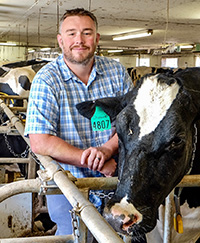Lindsay Ferlito, Cornell Cooperative Extension, works with producers to help them understand how their facility ranks for cow comfort. She presented “Monitoring and improving cow comfort in freestalls and tie stalls”as the August Hoard’s Dairyman webinar.
A common condition known as “barn blindness” occurs when an owner or employee is used to seeing the operation daily and does not notice when housing situations (or other items) have deteriorated. But, a fresh set of eyes from a third-party auditor can bring items to the attention of management that they may have overlooked.
Ferlito and her colleagues assessed cow comfort in freestall and tie stall barns. Items they monitored included lameness, injuries, lying time, stocking density, milk production, and overall health. The purpose of these evaluations was to determine cow comfort. Or, as Ferlito asked, “What is the cow telling us about their surroundings?”
Their research showed that herds that underwent an audit and received feedback then took the suggestions and made improvements. So, the audit was beneficial to the farm and ultimately the cows. Additionally, consumers want the confidence that the dairy products they are purchasing were produced under good animal handling practices.
What factors were included in these evaluations? Cows were scored for hygiene and body condition scoring (BCS), as well as hock, knee, and neck abrasions. From these scores, improvements can be made in stall design, headlock (or neck rail) position, bedding, and feed management.
When scores for cow comfort are positive, the herd is more profitable. Ferlito reminded listeners that not all changes in cow comfort have to include a huge financial output, like building a new barn, but subtle changes can make an impact. For example, on the farms they studied, increasing the amount of bedding in the stalls improved resting time, which in turn drove production upward.
Producers made favorable comments when they have had their herd evaluated. They appreciated an unbiased opinion and used the information to make improvements. In one instance, the evaluator provided insight that helped the producer identify lameness issues sooner, therefore minimizing the loss in production and stress to the cow.
Suggestions for stall width, length, and bedding surfaces are provided in the webinar. Surprisingly, few herds in Ferlito’s study had the desired dimensions.
Ferlito provided five case studies, looking at both freestall and tie stall facilities. To learn more about the specifics of the studies, you can watch the webinar.

To view more of our 100-plus webinars, visit www.hoards.com/archives.

Join us next month
Adam Lock, Michigan State University, will present “Incorporating supplemental fatty acids in dairy rations” on Monday, September 9, at noon (Central time).
Dairy cows at different stages of lactation respond differently to combinations of supplemental fatty acids. Lock will discuss how this knowledge can effectively be applied to the feeding and management of high producing cows.

The author is the online media manager and is responsible for the website, webinars, and social media. A graduate of Modesto Junior College and Fresno State, she was raised on a California dairy and frequently blogs on youth programs and consumer issues.








